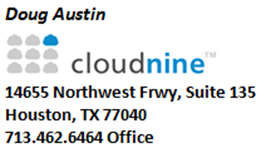Court Rules that Automatically Generated Read Receipt is Not Hearsay: eDiscovery Case Law

In Fox v. Leland Volunteer Fire/Rescue Department Inc., 7:12-CV-354-FL. (E.D.N.C. Mar. 10, 2015), North Carolina District Judge Louise W. Flanagan ruled that a Read Receipt automatically sent from the defendant’s email address to the plaintiff (when the defendant opened an email sent by the plaintiff) was not hearsay.
Case Background
In this wrongful termination case, the court was considering the defendants’ motion for summary judgment, as well as the defendants’ motion to strike certain exhibits attached to plaintiff’s brief in opposition to summary judgment for failure to comply with Federal Rule of Civil Procedure 56(c) & (e). One of the items that the defendants sought to exclude was a read receipt sent from defendant Grimes email address to plaintiff, triggered when an email plaintiff sent defendant Grimes was opened, arguing that the Read Receipt was “unauthenticated hearsay”.
Judge’s Opinion
Judge Flanagan made a swift ruling on this issue when she stated “Defendants’ argument fails. The Read Receipt is not hearsay.”
Explaining her ruling, Judge Flanagan started by questioning whether a Read Receipt email was even a statement, as follows: “As noted, hearsay is a declarant’s out of court statement offered to prove the truth of the matter asserted therein… As an initial matter, it is questionable whether the Read Receipt is a ‘statement’ at all. Federal Rule of Evidence 801(a) defines ‘statement,’ and specifically notes that a ‘statement’ must be ‘intended . . . as an assertion.’ Id. Here, it is questionable that the Read Receipt was intended to be assertive.”
Giving the benefit of the doubt that the Read Receipt qualifies as a statement under Rule 801(a), Judge Flanagan still ruled that “the read receipt is still admissible against both defendants where it is excluded from Rule 801…In particular, the email was generated by defendant Grimes, thus Rule 801(d)(2)(A) allows its admission against him. Rule 801(d)(2)(D), in addition, allows its admission against defendant Leland, because the statement came from defendant Grimes official email address, and defendant Grimes was required, as a function of his job, to investigate and respond to complaints of harassment.”
With regard to the defendants’ contentions that proper authentication under Federal Rule of Evidence 901(b)(1) & (4) of the Read Receipt was “impossible, because plaintiff failed to produce information about the email’s origin, including the mechanism by which it was generated” and that “plaintiff should have submitted a technical affidavit explaining how ‘read receipt’ emails are created, to ensure reliability”, Judge Flanagan stated that “the Read Receipt may be properly authenticated under Federal Rule of Evidence 901(b)(1) & (4).” Continuing, she noted that “the reliability of defendant Grimes’ email is not at issue, because the email is being admitted as a statement of a party opponent, which does not require the court to ensure reliability” and that “no technical affidavit is required to authenticate properly the Read Receipt… Here, defendant Grimes acknowledges receipt of plaintiff January 2, 2011, email referenced in the read receipt.” So, Judge Flanagan ruled that “the Read Receipt may properly be admitted.”
Ultimately, that proved to be a hollow victory for the plaintiff as Judge Flanagan granted the defendants’ motion to strike in part and also granted the defendants’ motion for summary judgment, closing the case.
So, what do you think? Was the court right to admit the Read Receipt? Please share any comments you might have or if you’d like to know more about a particular topic.
Disclaimer: The views represented herein are exclusively the views of the author, and do not necessarily represent the views held by CloudNine. eDiscovery Daily is made available by CloudNine solely for educational purposes to provide general information about general eDiscovery principles and not to provide specific legal advice applicable to any particular circumstance. eDiscovery Daily should not be used as a substitute for competent legal advice from a lawyer you have retained and who has agreed to represent you.







